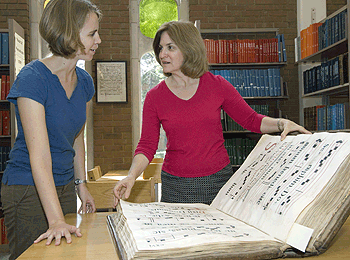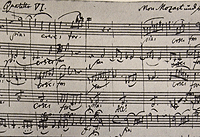Whether she’s trying to shed light on the music of the Middle Ages or come to grips with the life and work of a more recent composer such as Franz Liszt, musicologist Dolores Pesce is motivated by a single desire — to understand and communicate as accurately as possible what was in the mind of the composer at the moment of creation.
“While we can’t separate ourselves from our modern sensibility, the musical text and other contemporaneous documents leave enough clues to give us some sense of how the music might have been interpreted in its own time,” says Pesce, Ph.D., professor of music and chair of the Department of Music in Arts & Sciences.

“Musicology came out of Germany and into the United States as a positivistic science: First, you had to find and transcribe the manuscripts, that is, you had to provide a musical text for scholars and performers.”
Only after that’s done, Pesce says, can you begin to ask questions like, “What did it sound like?” “How did they play it?” “How did they hear it?”
To get at those kinds of questions, scholars like Pesce start looking to history and to non-musical documents to discern the rest of the story, such as the setting for the music and possible social and religious connotations.
“Especially in the Middle Ages, you’re trying to uncover how music could have spoken to an audience that was very much geared to oral expression and not necessarily literate,” says Pesce, who came to the University 25 years ago. “Were they hearing many more things than we’re hearing? And were they more capable of doing so? That, to me, is the interesting question.”
Trained in her early life as a pianist, Pesce grew up in Philadelphia in an Italian-American family; all four of her grandparents were born in Italy. Early on, she found herself surrounded by music, albeit the popular music of the day. Her father played the violin and her mother loved to sing.
“Once I started playing piano, my father and I played together,” she says. “We performed in the house, not publicly. It was wonderful. Our favorites were Nat ‘King’ Cole songs.”
From her junior-high years through her senior year of high school, Pesce studied with a piano instructor who enriched his teaching by bringing music theory into play and challenged her to think beyond the music that was on the page in front of her.
“He made me aware of the possibilities of thinking about music as a language,” she says.

When she went off to Goucher College in Baltimore, she initially wanted to study biology and genetics, but the call toward music was strong and, ultimately, the call to musicology won out over performance.
She went from Goucher to the Peabody Institute at The Johns Hopkins University, where her desire to teach and research was fueled even further. She was teaching community college and adult education music history courses when she applied for a Fulbright grant and subsequently spent a year doing research in Vienna, Austria, a place where she had always wanted to live.
That experience and her doctoral work at the University of Maryland sealed her fate as a teacher and scholar.
Pesce’s research in large part focuses on how medieval thinkers and composers understood the language of music and how the seminal act of notating music affected the decisions they made about pitch structures.
One of the individuals she has studied was an 11th-century monk named Guido of Arezzo, whose contribution to music theory is still practiced today in rehearsal rooms and choir lofts around the world: He proposed the “do-re-mi” system for teaching boys to sing.
|
Dolores Pesce Title: Professor and chair of music Born: Philadelphia Education: Bachelor’s degree, Goucher College, 1974; master’s of music, Peabody Institute of The Johns Hopkins University, 1976; doctorate, University of Maryland, 1982. Family: Husband, Bill; daughter Helen, 14, who will be a freshman at Clayton High School in the fall. Professional contributions: Pesce has published three books on the music of the Middle Ages and is working on a biography focusing on the later life and works of Franz Liszt. Of Liszt and his penchant for letter writing she says, “If he were here now, he’d be an e-mail person.” |
“He not only proposed that aid to singing, but he also promoted the use of what we now call the musical staff,” says Pesce, who also has researched and written about a particular 13th-century vocal genre called the motet. “Sometimes what we find before the 11th century is one line scratched onto the page; notators placed primitive pitch signs in relative positions to that one line. Arezzo said, ‘Why don’t we just use multiple lines instead?’
“So he’s the one who actually codified musical notation as we know it today. But he recognized that not everyone who wanted to sing would learn to read music. So he said, ‘If you’re using just the ear and can familiarize a person with the pitch relationships embedded in the syllables do-re-mi-fa, etc., then you can teach them a song.'”
The rest, as they say, is history.
Pesce’s musical interests don’t end with the Middle Ages, however. She is at work on a book about the music and life of the 19th-century composer and pianist Franz Liszt. Liszt was 75 when he died in 1886, a very old age at the time, and Pesce’s writing focuses on those latter years.
“He was a voluminous letter writer, in addition to being a prolific composer, so I am sorting out a great deal of evidence, which is a very different situation from my medieval research where the evidence is sparse,” says Pesce, who has access to Liszt’s many letters and manuscripts in Weimar, Germany, where he lived from roughly 1842-1861.
“I find Liszt fascinating because, coupled with the more glamorous aspects of his virtuosic, woman-loving persona at an early age, he was a very deep thinker. I’m fairly sure that he had his moments of depression, particularly the type that’s associated with aging, but I also believe that he had a spiritual grounding that kept him going. This introspective, spiritual character dominates his later years and is what I hope I am bringing alive through my writing.”
Pesce has chaired the Department of Music since July 2005 and served as acting chair for a brief period three years prior to that. She teaches one course each semester, either for undergraduates or for doctoral students in musicology.
She loves to teach, she says, and her doctoral students have come to appreciate all that she brings to that experience.
“I’ve taken many classes with Dr. Pesce and now I am writing my dissertation under her guidance,” says doctoral student Sarah Ruddy. “Because of her diverse research interests and her constant willingness to delve into new topics along with her students, a lot of people are drawn to her as an adviser. I feel like she’ll do whatever she can to see her students succeed.”
Pesce says the department is in a period of growth right now, building on a solid foundation of Western art music but also strengthening its offerings in other areas such as jazz, musical theater and world music.
The department has about 40 music majors, along with 50 or more minors, roughly 500 people taking music lessons, and another hundred or so involved in ensembles.
“Under Dr. Pesce’s leadership the department has taken significant steps in filling essential faculty positions and in improving our facilities in ways that affect students and teachers in extremely positive ways,” says her colleague Craig Monson, Ph.D., professor of music and director of graduate studies. “She works tirelessly for us all, and faces challenges, even the most daunting, with an infectious optimism.”
“We are becoming more competitive in attracting both undergraduate and graduate students who have interests that go beyond Western art music because we’ve made several excellent faculty hires in the last few years,” Pesce says.
“We want as many students as possible to have the opportunity to take music courses, as well as music lessons. Our message is, ‘Come to the music department and get involved in the fine arts. You promote music by performing it, but if you’re able to talk about it in a literate way, you also help perpetuate it.'”